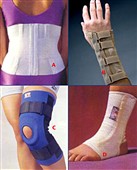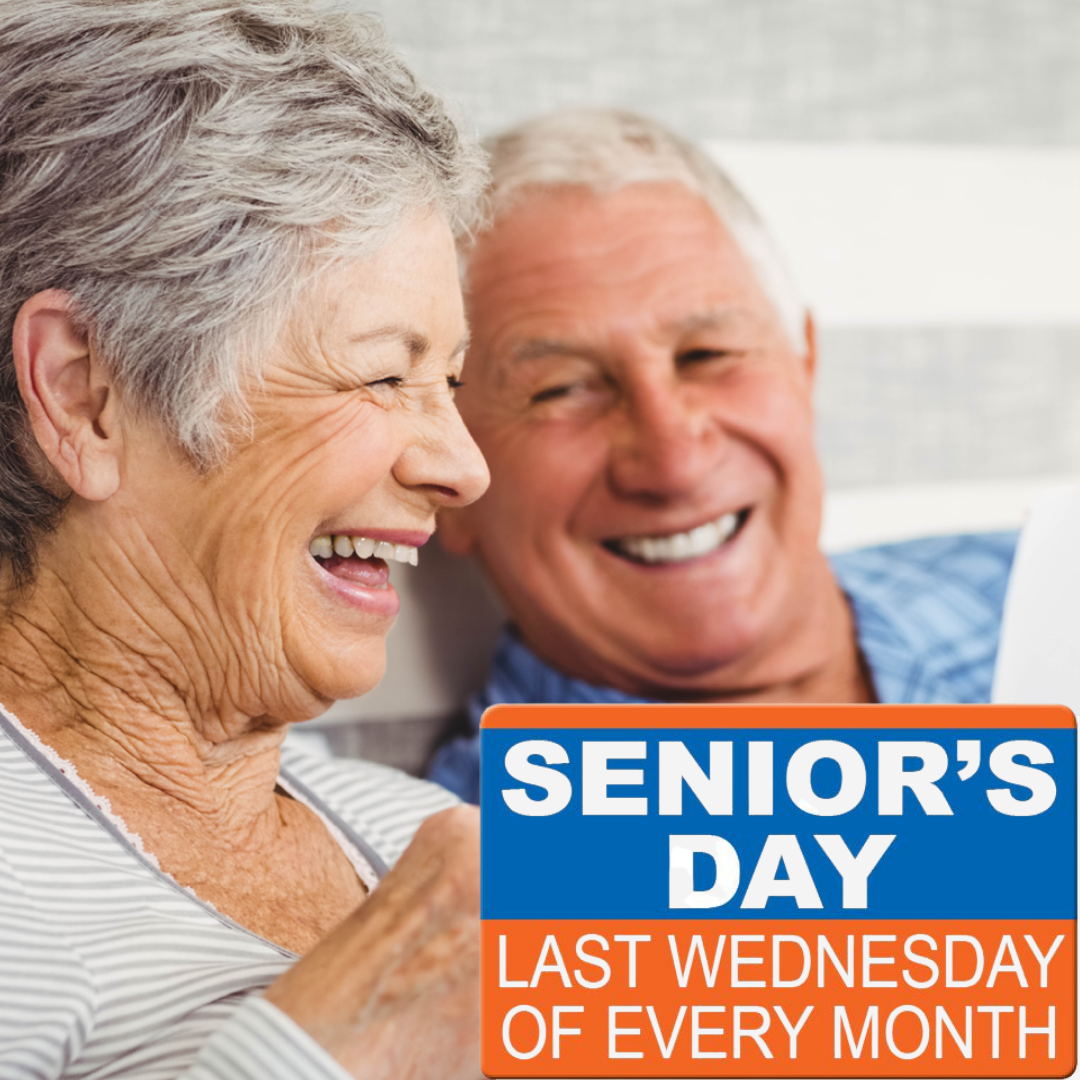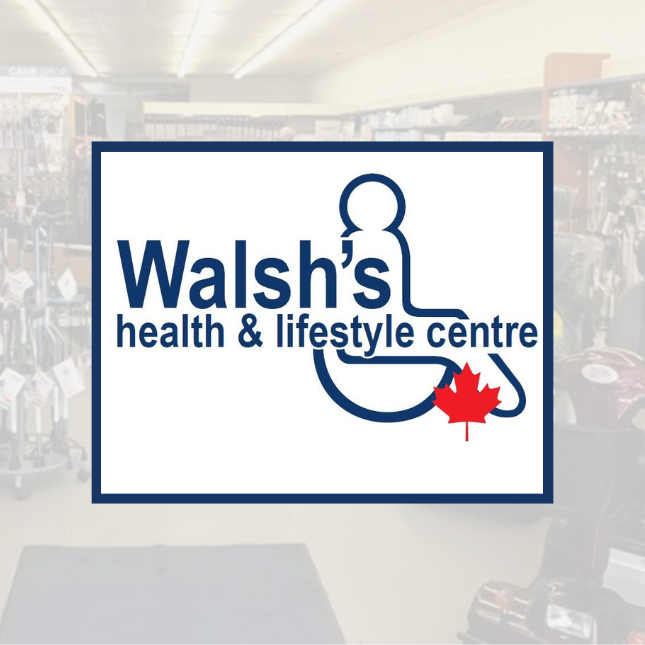Braces and Supports
 ANKLE INJURIES
ANKLE INJURIES
Ligaments can be sprained, partially torn, or completely torn. The most common case of injury involves the calcaneofibular ligament. Causes of ankle injuries include: weak muscles, uneven surfaces, improper shoes, and flat or high arched feet.
WHICH ANKLE SUPPORT TO RECOMMEND
Elastic Pull On: Provides compression and offers a mild support. Indications include tired aching ankles, mild sprains and strains.
Neoprene Ankle Supports: Provides mild compression and warmth. Indications include arthritis, sprains, strains and any other mild ankle injuries.
Lace-Up Ankle Supports: Provides good support for ankle. Can usually replace taping, and should fit easily in any shoe. Lace-ups control rotation, and aids in prevention of inversion and eversion (turning over on your ankle). Lace-up supports can also be used as a prophylactic measure.
Indications include severe ankle sprains recurrent ankle injuries, post-operative ankle support, and longterm management.
KNEE INJURIES
Ligaments can be stretched or torn from the bone by activities that twist the knee. The medial and lateral collateral ligaments found on the outside of the knee joint, provide side-to-side stability. Once the ligaments are torn or stretched, a knee support may be needed. Causes of knee injuries include overuse of muscles, ligaments, and improper use of muscles.
WHICH KNEE SUPPORT TO RECOMMEND
Elastic Knee Brace: Pull-on knee braces provide light compression. Elastic knee braces must give enough support but not cut off circulation. Elastic knee braces stretch and contract to conform to body shape.
These supports are recommended after a knee injury has healed, and for weakened knees, and mild strains.
Knee Warmers: Usually made from a high percentage of wool giving mild support, while providing warmth for soothing comfort. Choose for clients with arthritis.
Neoprene Knee Braces: Available in open and closed patella. Open patella is great for additional flexion. Horseshoe felt pads can be found in neoprene braces for additional support. Neoprene supports provide warmth to increase blood flow and compression for supporting muscles, ligaments, and cartilage. Upper and lower velcro straps provide further stabilization. Closed patella braces work well to reduce swelling in the knee joint. Indications include acute knee injuries, sprains, strains, arthritis of the knee joint, arthroscopic surgery, Osgood Schlatter, and patellar tendonitis (also known as JUMPERS knee).
Neoprene Hinged Knee Brace: Available with removable medial and lateral (side-toside) metal hinges. The hinge prevents hyperextension and any medial or lateral movements. "U"-shaped pad aids in patella support and upper and lower straps also aid in further stabilization, Indications include Chondromalacia, anterior cruciate ligament stabilization, and patella tencionitis.
TENNIS/GOLFER'S ELBOW
Tennis or golfer's elbow occurs where there is excessive use. It is an inflammation of the tissues in the elbow area. Tennis elbow involves the muscles and tendons that extend or bend the wrist and fingers. The pain occurs on the outside of the elbow, in contrast to the condition of golfer's elbow, the pain is on the inside. Causes of tennis elbow include weak muscles, overuse, and improper use of equipment. Although tennis elbow is very painful, it is treatable. Rest, ice, proper stretching, and physiotherapy (physios will work to reduce the inflammation in the arm), and antiinflammatory prescription drugs are often part of the treatment.
WHICH TENNIS ELBOW SUPPORT TO RECOMMEND
Tennis elbow can be treated or relieved by a snug band (not elastic) wrapped around the forearm approximately one to two inches below the elbow. A tendon pad in the brace provides concentrated compression on the muscle-tendon giving more support. Indications include sprains, strains, bursitis, tendonitis of the elbow and arthritis.
WRIST SUPPORTS
Many muscles are responsible for wrist movement. The muscles which control movement are located in the forearm. When injury stretches or tears these tendons and ligaments, immediate care is required. The result of injuries consists of swelling and weakness of the joint. A typical way to reduce swelling is to apply a cold compress to the affected area, followed by a compression support of the joint. A wrist support can semi and fully immobilize the joint usually leaving the fingers to move freely.
WHICH WRIST SUPPORT TO RECOMMEND
Pull-On Elastic: Like other elastic supports, the pull-on wrist brace is best suited for very mild strains and sprains. As these usually come already sized they are unable to be adjusted.
Wrist Brace with Palmer Steel: Generally available in elastic or neoprene. This brace can be adjusted for tension and is easily applied and removed. The steel can be removed when conditions diminish and can be worn as a mild support. Indications include Carpal Tunnel Syndrome, sprains, strains, chronically weak wrists, post-operative rehabilitation, and arthritis.
BACK SUPPORTS
The curved vertebral spine consists of 24 vertebrae: five lumbar vertebrae, twelve thoracic vertebrae, and seven cervical vertebrae. The lumbar (lower back) are the largest and consequently have the most weight to bear. Each of these vertebrae are separated by intervertebral disk. These disks absorb and cushion the shock by such activities as walking and jumping. There are many factors which contribute to low back pain, beginning with poor posture, lack of exercise, and overeating.
Back Sprains: Like any other part of the body, sprains occur when the muscles or ligaments are stretched or torn, thus activities done improperly such as bending, lifting, standing or even sifting are all contributing factors.
Herniated or "Ruptured" Disks: A herniated disk occurs when the disk that is found between the vertebrae shifts or bulges and stimulates nerve endings. This pain then travels down the back of the thigh to the leg-is a condition called SCIATICA. Although most people do not require an operation for this ailment, a very small percentage will.
Osteoarthritis: When aging, many people develop the aches and pains of osteoarthritis that accompany old age. Osteoarthritis is one of those inevitable conditions. In the lumbar area, Osteoarthritis affects the disks by making them narrow, causing the vertebrae to rub against one another, resulting in irritating spurs, and pain. Proper exercise, and correct use of your back will prolong any wear and tear.
WHICH BACK SUPPORT TO RECOMMEND
Elastic Lumbosacral Supports: Elastic supports are used as a prophylactic while on the job as a preventative measure against recurring back injuries, due to improper bending, lifting, and reaching. They usually have a velcro closure, facilitating the adjustment of tension as needed. Stiffness, mild low back pain, and post-operative support are some other indications.
Lumbosacral Corsets: These corsets are made from a heavy cotton material, with side lacing. These supports must be measured and fitted properly, thus a registered fitter is required. There are metal stays that may be placed in the back, but only by request of a doctor (you must have a doctor's prescription to fit this brace, and must be able to know how to properly bend the metal stays to conform to the client's back). Indications include chronic and acute back pain, sciatica, sprains, and strains.
Sacro-illac Supports: The sacrum is located below the lower lumbar region, at the base of the vertebral column. The sacrum has five vertebrae which are fused together into one bone during the early years of skeletal development. When fitting a sacro-iliac support, positioning is crucial. It should not be confused with a lumbosacral support (sacro-iliac supports are usually not as wide).
Harris Brace: The Harris Brace must only be measured and fitted by a Registered Orthotic Fitter.
.png)
.png)





